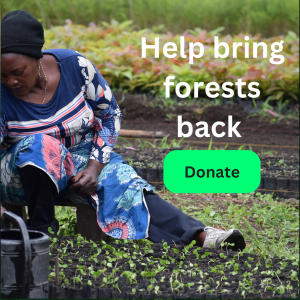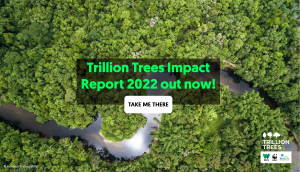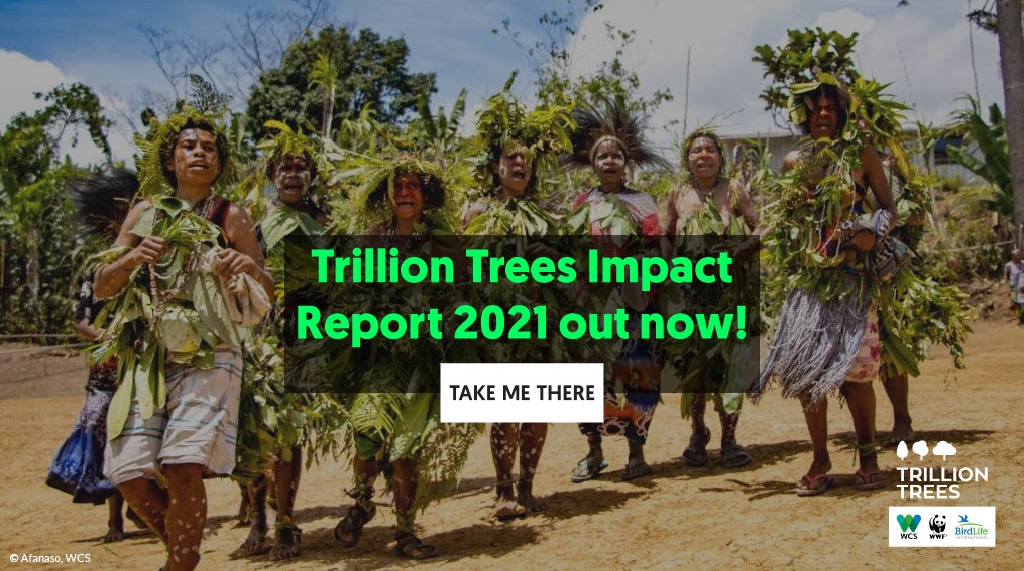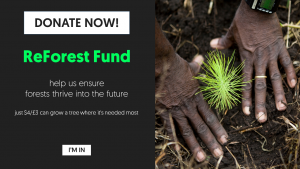What is Trillion Trees?
Trillion Trees is an unprecedented joint venture between three of the world’s largest conservation organisations – BirdLife International (BLI), Wildlife Conservation Society (WCS) and the World Wide Fund for Nature (WWF). Our shared commitment is to end deforestation and restore forests. Together we have huge reach, resources and expertise. And decades of experience in saving forests. We believe that joining forces as partners in Trillion Trees will achieve more than working separately.
Why a trillion trees?
The scale of the world’s forest destruction is disastrous and unsustainable. There used to be six trillion trees on our planet – now there are only half that number. And we keep losing 10-15 billion trees a year. Without drastic action, we could lose the world’s rainforests this century. This could cause unknown catastrophic consequences for people and biodiversity (ref).
The Trillion Trees target of protecting and restoring one trillion trees was chosen because it is ambitious, but achievable. But it’s also a worldwide goal for all sectors of society, not just one organisation. It is essential for delivering on the Paris Agreement on climate change. And for restoring the natural world we depend on, securing a better future for us all.
Are we planting one trillion trees?
No. Protecting and restoring forests is one of the most effective and immediate solutions to the triple crisis we face – climate change, biodiversity loss and socioeconomic inequality. Planting trees is just one approach we take. We aim to reduce deforestation, improve forest protection and advance restoration. Restoration involves both tree planting and natural forest regeneration, with strategies determined by the local context (See What is the difference between tree planting, forest restoration and protection?). Without protecting our standing forests, no amount of restoration will matter.
Can we solve climate change by planting a trillion trees?
No. A planet with more trees is vital for tackling the climate crisis – we know we need A LOT more trees. But it is not the only solution. To halt climate change, we need rapid, dramatic reductions in greenhouse gas emissions – which means quitting fossil fuels and decarbonising energy, transport and industry. Just as importantly, we need to keep all of our remaining forests standing. Without protecting our standing forests, no amount of restoration will matter.
Trees are crucial for removing excess CO2 from the atmosphere in one of the most natural, efficient and cost-effective ways. Trees that are cut down or burned, on the other hand, release the CO2 they were storing – deforestation accounts for 10% of global emissions. If it was considered a country, it would come third (behind China and the US). Which is why tree-planting and restoration has to be accompanied by forest protection.
Can we achieve our vision alone?
No, our vision is a global one. We are part of a global movement working collectively towards protecting and restoring one trillion trees, together.
It requires commitment and action from governments, businesses, non-government organisations, communities, and individuals all across the world, many of whom are already pursuing similar goals. Our role is to add to this collective effort, by working in landscapes and regions to drive real change on the ground, by demonstrating approaches that others can replicate, and by inspiring change across different sectors.
What are the right trees in the right places?
Trillion Trees projects are not always about planting trees. Many times they are focused on protecting existing forests and helping them thrive. Or creating the right conditions for degraded forests to regrow naturally.
The Trillion Trees’ maxim is ‘The right trees in the right places, in the right way’. The first principle is that native standing forests should stay as they are. They are already in the right place. We protect them where they stand – and we promote local socio-economic development that discourages deforestation.
For forest restoration work, Trillion Trees follows the principles of Forest Landscape Restoration.
We focus on entire landscapes. We take into account the land use dynamics around the restoration area, as well as inside it. Our projects are designed for long-term sustainability. Economic, social and ecological. To benefit people, climate and nature.
We prioritise natural regeneration wherever possible. Encouraging native plant growth and diversity is best for wildlife, climate and people. And often it’s the most cost-effective approach. If forests cannot regrow naturally, if the land is too degraded for example, we might then opt for assisted regeneration or tree planting. Where tree planting is needed we prioritise native species, with the right levels of genetic diversity. Planting non-native trees is only done if there is a clear socio-economic, ecological or climatic reason. For example, non-native fruit trees or high-value timber species can provide economic benefits, which in turn will help reduce deforestation overall.
Any non-native species we plant will have been widely tested to prevent negative environmental impacts. And they would never be planted in conservation areas. Tree-planting should also never replace important and healthy natural ecosystems – such as grasslands, wetlands and peatlands.
It is crucial that the trees we plant are kept alive for the long-term. We factor in ongoing forest management costs when allocating funds to our projects. We work closely with our experienced in-country teams and partners. They understand the local context, making sure the right trees are planted in the right places. This gives the trees the best possible chance of surviving and thriving. Our work also tackles the causes of global deforestation, helping to minimise the risks of damage and loss to our trees and others.
The exact activities we propose for each project are based on achieving maximum impact. If you would like to talk about details of particular projects, or how money is invested, please get in touch at action@trilliontrees.org.
What is the difference between tree planting, forest restoration and protection?
We hear a lot about tree planting and restoring forests, but what is the difference? Tree planting is just as it sounds, and maybe you’ve done it yourself. Tree planting is a type of restoration activity and important for restoring ecosystems that are too degraded to naturally regenerate. You could plant a tree anywhere, but it might not have value in bringing back a forest. Think planting an apple tree in your garden. This is great, but it’s not going to help a natural ecosystem.
When we talk about restoring forests, it’s because this can be so much more and is about helping recreate an entire ecosystem – removing invasive ferns to help native seeds regrow on their own, working on activities that will help bring back better soils or cleaner water, and also tree planting – there are so many things involved.
How does Trillion Trees work with local and indigenous communities?
One of our priority approaches is to engage with local community groups from the earliest stage. We involve everyone in the decision-making that affects their lands and livelihoods. And we don’t move forward without consent and participation. We work towards active participation and leadership by the communities. We also help indigenous peoples to formalise their rights to forest land – to manage forests sustainably, and to benefit from them.
All three Trillion Trees partners are committed to, and are founding members of the Conservation Initiative on Human Rights. This recognises our responsibility to address and be accountable for the social effects of our work. And establishes a common set of principles that we are committed to following.
If you have questions about any Trillion Trees projects, our approach to working with communities and indigenous peoples, or our commitment to human rights, please contact action@trilliontrees.org.
You can also find details of the individual policies and safeguarding practices of our partner organisations at the links below.
BirdLife: Conservation and Rights
WCS: Conservation and Human Rights
WWF: Environmental and Social Safeguards
How does Trillion Trees decide where my donations are spent?
The Trillion Trees partners work in forest landscapes across the globe, and they have prioritised specific forests needing protection or restoration. Particularly projects that use and build on established working relationships, to make sure we achieve the biggest impact. The majority of our projects are in tropical forests, because that is where there are the biggest risks, but also the largest gains to be made.
In many landscapes, the Trillion Trees partners have been working there for decades, enabling trust and strong relationships with the communities, governments and other stakeholders necessary to ensure conservation success.
All donations to Trillion Trees are spent on developing, running, monitoring and managing forest conservation projects. Funds are granted to our field teams and/or partners who carry out the work.
Can Trillion Trees fund other people’s tree-planting projects?
We do not have funds available to offer grants to other projects at this time. But we do wish you good luck with your own forest projects – and thank you for sharing Trillion Trees vision for a more forested, healthier planet.
What is the cost of growing a tree?
First, it is hard to give a single answer to ‘how much does tree planting or forest restoration cost?’ – it varies from region to landscape to project, depending on the type of restoration. Second, it’s not just about getting a tree in the ground, but growing that tree to maturity. The full cost includes not only a tree sapling, but also the expense associated with growing it in a nursery, planting it out, and time spent nurturing and monitoring it, often over years, to ensure maximum survival rates.
There is as yet no standardised approach to assessing costs of ecosystem restoration. Some methods report only the initial cost, whereas others include ongoing maintenance (1). Cost is also linked to the type of restoration – for example whether it is natural regeneration, seed planting, or nursery propagation and sapling planting. Trees grown on working farms can be cheaper because farmers contribute their labour to planting and aftercare, and derive benefits from the trees. Restoring a natural wild forest, on the other hand, may be more expensive because the extra maintenance costs need to be covered.
Estimated costs per hectare vary widely: from $1,400/ha at the low end (relying on natural regeneration), to $34,000/ha for large-scale active restoration (2, 3). Recent research suggests a global average of $2,328/ha (4). High levels of monitoring can account for up to 20% of a project’s budget – this is often overlooked in funding calculations, but it can be crucial for the success of tree-planting and forest restoration projects.
You can learn more about the real cost of restoring forests in our paper here
What type of trees are being restored?
Most of the trees grown in Trillion Trees projects are species native to the local forest. The goal of our work is to restore natural forests which will recover habitat for biodiversity, and also protect ecosystem services such as water for communities around a forest. So the trees planted are a diverse mix of the species appropriate for the particular place, selected by our teams, in consultation with other experts.
In certain cases, we may also work with farmers to put more trees on their farms, supporting sustainable agroforestry. This helps to stabilise the land and provides usable wood, fruit and other crops for a variety of purposes. This is not the majority of our work, but it can be important to provide an alternative source of money for communities, which will keep the newly restored native forest growing and standing long into the future.
How can I support Trillion Trees?
We have made it easy to get involved and make your impact with Trillion Trees, at every level of financial commitment.
You can make an immediate secure donation to Trillion Trees here.
If you want to contribute larger amounts, or in a different way, our team would be happy to discuss all options with you. We can for example tailor your contribution and support to a specific project.
Get in touch with us at action@trilliontrees.org.
Everyone can also take their own personal direct action every day to help protect and restore forests – for example:
- Learn about the environmental impacts of the products you use and buy. Everyone can make better choices by selecting products and brands that commit to responsible, deforestation-free, forest-friendly sourcing.
- Support political and community leaders who advocate for better protection for forests locally, as well as around the world.
- Plant trees in your own community – making sure they are the right trees for your area.
- You can help us ensure the right trees are restored in the right places by donating to the ReForest Fund





